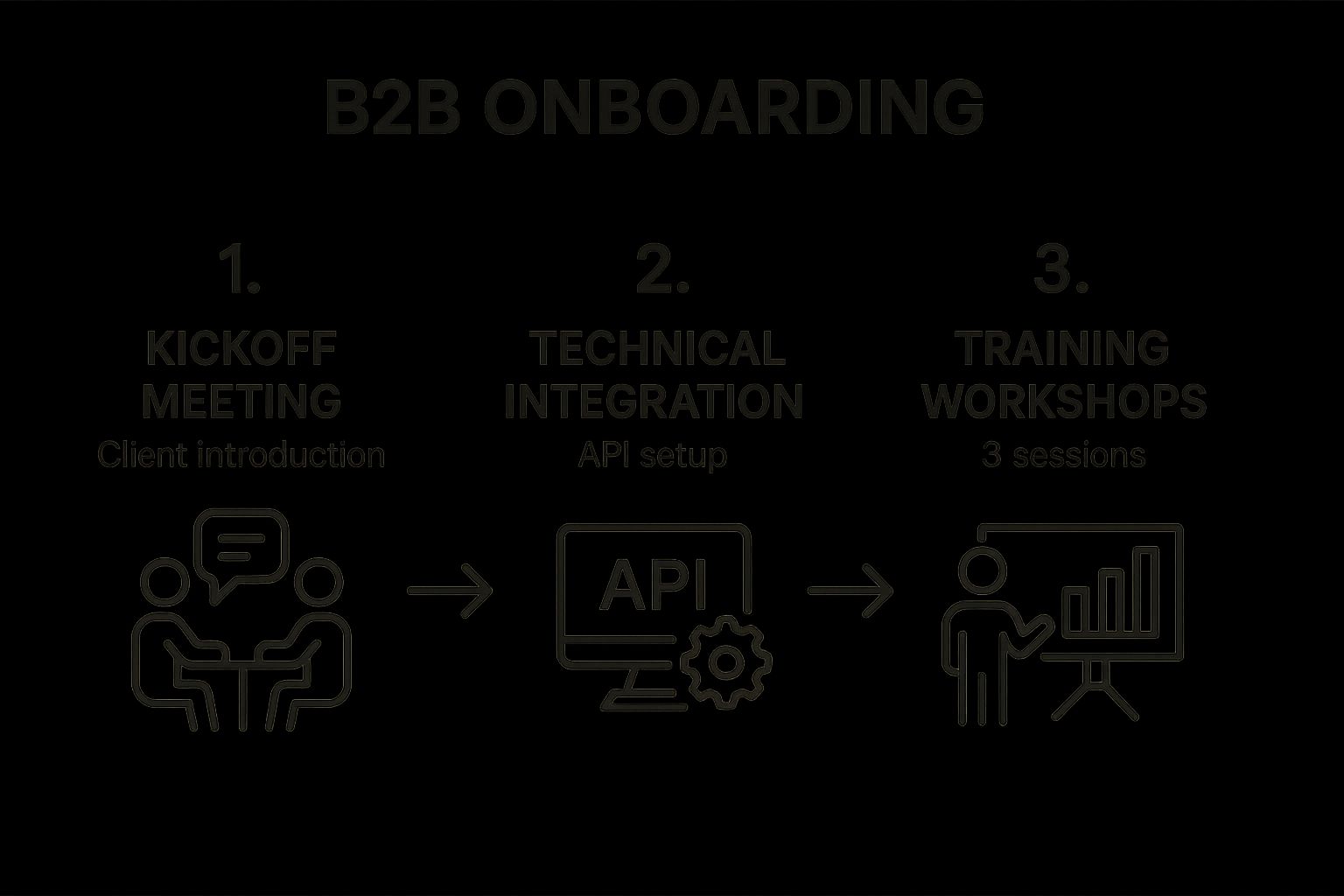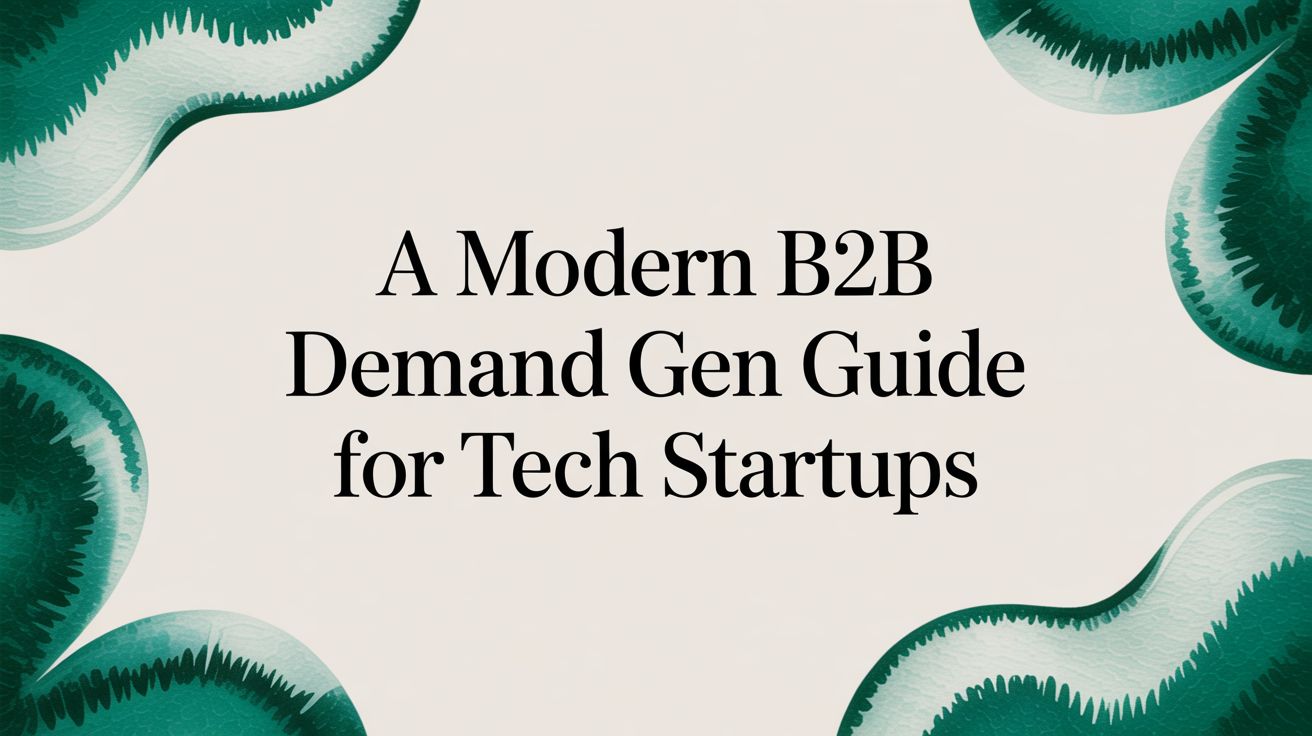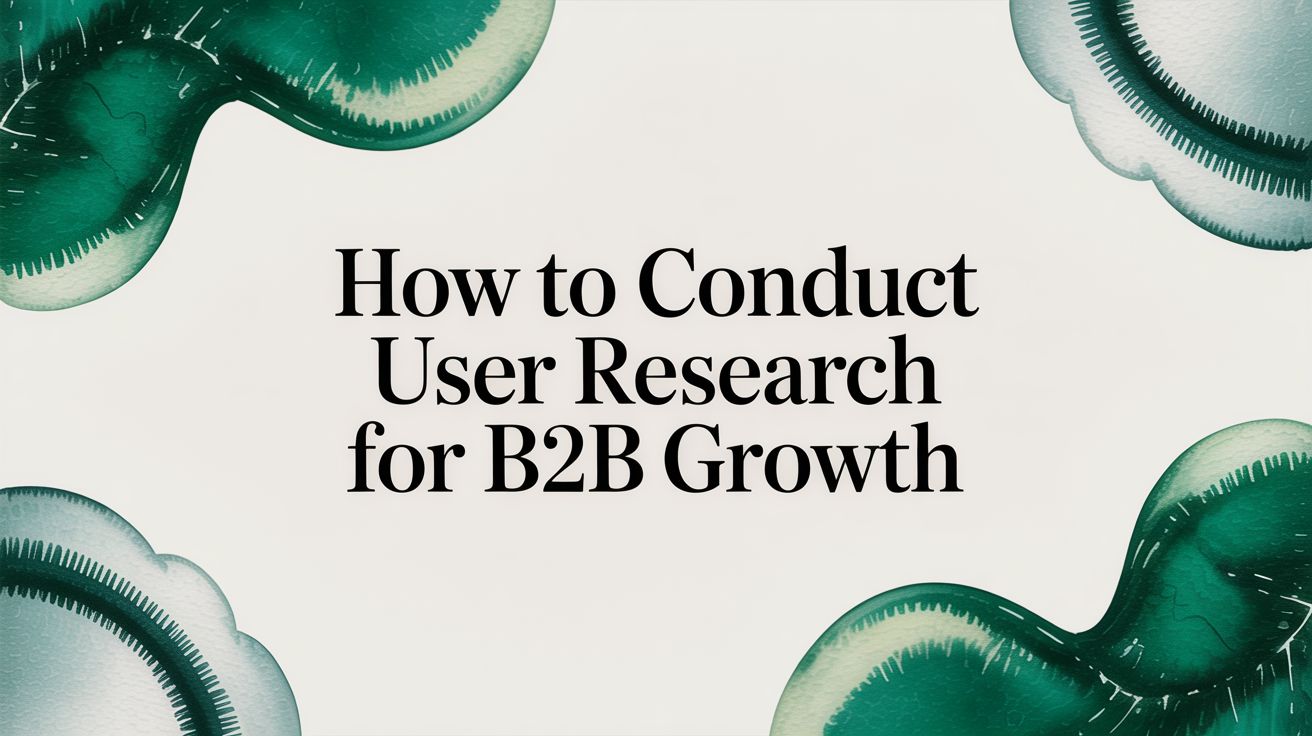Craft Your B2B Customer Journey Map
July 25, 2025

A B2B customer journey map does one thing exceptionally well: it tells the complete story of every interaction a potential customer has with your company. It’s the visual narrative that gets everyone—from marketing and sales to product and support—on the same page, all focused on a single, shared understanding of the customer experience.
Why Journey Mapping Is Your New Competitive Edge

In a world filled with complex sales cycles and digital-first everything, the B2B customer journey map has become much more than a marketing diagram. It's now your most important strategic compass, giving you the clarity needed to navigate the long and often winding path your future customers take.
Think about it. A typical B2B purchase involves multiple decision-makers, weeks of research, and dozens of touchpoints across different channels. Without a map, your teams are flying blind. Each department ends up with a fragmented picture of the customer’s needs, motivations, and pain points.
This disconnect inevitably creates friction. Marketing generates leads that sales struggles to convert. The product team builds features that don't solve the real-world problems uncovered during sales calls. A journey map breaks down these silos for good.
Align Your Entire Organization
When every team is looking at the same map, they can finally work together to create a cohesive, seamless experience. This shared perspective empowers your company to:
- Pinpoint Friction: You can see exactly where prospects get stuck, frustrated, or drop off, letting you remove those roadblocks before they kill a deal.
- Uncover Opportunities: The map will reveal hidden moments where you can add unexpected value, delight a prospect, and stand out from the noise.
- Design for Loyalty: It helps you shift from a short-term, "win the deal" mindset to building an end-to-end experience that turns customers into long-term advocates.
The move to a buyer-centric world is no longer a trend; it's the standard. In fact, by 2025, it's estimated that 80% of B2B sales interactions will happen through digital channels. Buyers now expect the same fluid, personalized experience in their professional lives that they get as consumers. Getting a handle on this digital-first behavior isn't just a good idea—it's critical for survival.
A journey map isn’t just about observing the path; it’s about intentionally designing a better one. It transforms your company from being reactive to customer issues to proactively shaping a superior customer experience.
The Stages of the B2B Journey
To build an effective map, you first need to understand the distinct phases a B2B buyer moves through. While every business is different, most journeys follow a predictable pattern from initial awareness to loyal advocacy.
Here’s a quick look at the typical stages:
Understanding these stages allows you to tailor your content, messaging, and support to what the buyer needs at that specific moment, making the entire experience feel more intuitive and helpful.
From Diagram to Growth Engine
At the end of the day, a B2B customer journey map is much more than an empathy-building exercise. It's a direct line to sustainable growth. The insights you gain will inform smarter decisions across the entire business, ensuring every ounce of effort is focused on what truly matters to your customer.
By visualizing the complete story of your customer's experience, you can finally move from guesswork to data-driven action. This allows you to fine-tune every touchpoint, from the first ad they see to the moment they rave about your solution to a colleague. For SaaS startups and tech firms, this level of strategic focus is what separates the market leaders from everyone else. To learn more about this, check out our guide on how to fuel your B2B marketing for digital growth.
Laying the Foundation for Your Journey Map

Before you can even think about charting a single touchpoint on your B2B customer journey map, you have to get to know the traveler. A map built on assumptions is just a pretty poster for your wall. But one built on a solid foundation of clear objectives and real human insight? That’s a powerful tool for growth.
Honestly, this foundational work is non-negotiable. It’s the critical difference between guessing what your customers need and knowing what truly drives them. Every decision you make from here on out will stand or fall based on the quality of the groundwork you lay right now.
Define Your Business Objectives First
So, why are you really creating this map? Without a clear "why," your efforts will be scattered and lack direction. Your map needs a mission, a specific business goal it's designed to help you achieve.
Think of your objective as the lens through which you'll view the entire journey. It keeps your attention focused on the moments that matter most and stops you from getting bogged down in useless details.
For a SaaS startup, some common objectives I see are:
- Boosting lead-to-demo conversion rates: This means focusing like a laser on any friction in the early consideration stage.
- Slashing customer churn: Here, you'll zero in on the onboarding and adoption phases to make sure customers find success early.
- Streamlining the trial-to-paid process: Your map will help identify what makes trial users commit versus what makes them walk away.
- Increasing expansion revenue: This involves mapping the journey of existing customers to spot natural opportunities for upselling.
Pick one primary objective. I can't stress this enough. That clarity will guide your research, shape the questions you ask, and ensure your final map delivers measurable results. Once that goal is crystal clear, you can move on to figuring out who you're building this for.
A journey map is not a one-size-fits-all document. Its power comes from its specificity—being tailored to a particular goal and a specific type of customer.
Crafting Data-Backed Buyer Personas
The heart and soul of your B2B customer journey map is the buyer persona. And no, I'm not talking about creating a generic avatar with a stock photo and a cute, alliterative name. This is about building a detailed, data-backed profile of your ideal customer, rooted in real research.
A weak persona inevitably leads to a weak map. You need to push past basic demographics and dig into the psychographics—the goals, motivations, and frustrations that shape their decisions at work.
For example, let's imagine two potential buyers for a project management SaaS:
Persona A: "Strategic Sarah" - The CTO at a Mid-Sized Firm
- Her Goal: Improve engineering velocity and nail security compliance.
- Her Pain Point: Her current tools are a fragmented mess, creating data silos and security nightmares.
- Her Decision Drivers: She's all about API integrations, robust data security protocols, and long-term scalability. She'll need to see a technical whitepaper and a detailed security brief before making any moves.
Persona B: "Manager Mark" - The Marketing Manager at a Startup
- His Goal: Keep his team on track with campaign deadlines and prove marketing ROI to the higher-ups.
- His Pain Point: A total lack of visibility into project progress is causing missed deadlines and last-minute chaos.
- His Decision Drivers: He cares about ease of use, simple reporting dashboards, and getting his team onboarded fast. He'll be looking for case studies from similar startups and a quick, frictionless free trial.
These two people are on completely different planets, and so are their journeys. Sarah’s path is going to involve deep technical dives and security reviews. Mark’s journey will be all about team efficiency and seeing immediate results. Trying to map a single, generic journey for both of them would be utterly useless.
Getting this level of detail is essential for mastering the customer journey in B2B and creating a map that actually works.
The depth of your initial research directly dictates the quality of your final map. Take the time to conduct interviews, sift through your CRM data, and genuinely understand the people you're here to serve. This foundational work will pay off in spades, transforming your map from a simple diagram into a strategic asset that guides your entire company toward customer-centric growth.
Gathering Data That Brings Your Map to Life

A B2B customer journey map built on gut feelings is little more than a guess. To create something truly powerful—a tool that aligns your entire company and genuinely drives decisions—you need to ground it in reality. This means digging deep to gather the right mix of data that brings the customer’s complex story to life.
The real magic happens when you blend two distinct types of information. You need the stories, the feelings, and the motivations behind your customers' actions. But at the same time, you need the hard numbers that show what they're actually doing.
Uncovering the "Why" with Qualitative Insights
Qualitative data gives your map its heart. It’s the "why" behind the numbers, providing the context and emotion that analytics alone just can't capture. This is where you move beyond assumptions and hear directly from the people you aim to serve.
For a SaaS startup, this can be incredibly revealing. You might think your onboarding is smooth, but a handful of interviews could expose a critical point of confusion that’s causing users to stall and churn before they ever see the value.
Some of the most effective methods for this are:
- Customer Interviews: Have real, candid conversations with 5-10 of your best customers. And don't forget to talk to a few you recently lost—their perspective is often even more valuable. Ask open-ended questions about their initial problem, how they searched for a solution, and what their experience was really like.
- Targeted Surveys: Use tools like SurveyMonkey or Typeform to ask specific questions at key moments. A short survey after a sales demo or at the end of a trial can provide invaluable feedback right when the experience is fresh in their minds.
- Support Ticket Analysis: Your customer support team is sitting on a goldmine of data. Look for recurring questions, complaints, and feature requests. These are direct signals of common friction points in the customer journey.
The most powerful insights often come from a simple, direct question: "Can you walk me through how you accomplished [a specific task]?" The story they tell will reveal more than any multiple-choice survey ever could.
This information is crucial for building out accurate buyer personas that feel like real people. To learn how to translate these insights into actionable profiles, check out our complete guide on using buyer personas to accelerate B2B marketing and sales.
Pinpointing the "What" with Quantitative Data
While stories provide the soul, quantitative data provides the skeleton of your journey map. These are the hard numbers that validate (or sometimes, completely challenge) your qualitative findings. They pinpoint exactly where the journey is breaking down with undeniable evidence.
You absolutely need to know what customers do, not just what they say they do. This is where you connect their digital behavior to their experience.
For a tech firm, your key sources of quantitative data will be:
- CRM Data: Your CRM tracks the entire sales cycle. Dive into lead source data, conversion rates between stages, and the average sales cycle length for different customer segments. Are deals from a certain channel stalling at the same stage? That's a huge clue.
- Web Analytics: Tools like Google Analytics show you the actual paths users take on your website. Identify the most-visited pages, where users enter, and, more importantly, where they exit. A high drop-off rate on your pricing page, for example, is a major red flag that demands immediate investigation.
- Product Usage Logs: For any SaaS company, this is non-negotiable. Track key actions within your product to see if users are adopting the "sticky" features that lead to long-term success. Or are they getting stuck right after the initial login? The logs will tell the tale.
An effective B2B customer journey map absolutely hinges on combining these two worlds. The real breakthroughs happen when you connect the frustration a user expresses in an interview with a specific drop-off point you see in your analytics. This synergy helps you understand not just what buyers do, but why they do it.
To gather all this comprehensive data in one place, tools like a customer relationship management (CRM) system are invaluable. For startups wanting maximum flexibility, you might even consider exploring options for creating a custom CRM that you can tailor to your specific data needs.
By merging the human story with the hard data, you create a rich, three-dimensional view of the true customer experience. That's the foundation of a map that works.
Visualizing the Journey from First Touch to Advocacy
You’ve done the hard work of research and you’ve got your personas nailed down. Now for the fun part—this is where you get to see all those disparate pieces of data click into place and tell a story. It’s time to transform all that raw information into a clear, visual narrative: your official B2B customer journey map.
Think of this map as your company’s blueprint for empathy. It’s a tool that lets your entire team step directly into a customer’s shoes, seeing the world from their perspective. From the very first time they hear your company’s name to the moment they become your most vocal advocate, this map will guide you.
Structuring Your Map Component by Component
To get started, you need a solid framework. The best journey maps I've seen break the customer experience down into logical components, usually laid out in a grid or a flowchart. This structure is what ensures you capture the complete picture, not just a few isolated touchpoints.
You’re essentially building a story, scene by scene. For each stage of the journey, you'll document what your customer is actually doing, what’s going through their head, and how they’re feeling.
To make sure your map is comprehensive, let's break down the essential elements. A good template will always include these core components, which help you see the complete picture from every angle.
B2B Journey Map Template Components
Having these distinct components prevents you from missing crucial details. It forces you to think holistically about the experience—not just what the customer does, but what they think and feel along the way.
A SaaS Journey from Start to Finish
Let's make this real. Imagine your persona, "Strategic Sarah," a CTO on the hunt for a new cybersecurity platform. Here’s how her journey might look on your map.
Awareness: Sarah is scrolling through LinkedIn and sees a sponsored post about a new data breach threat. Her action is simple: she clicks the link. Her immediate thought is, "Are our systems even protected against this?" She feels a mix of concern and genuine curiosity. The touchpoint here is your company's blog, delivered via a social ad.
Consideration: After reading a few articles, she decides to sign up for a webinar you’re hosting on mitigating this exact threat. Her action is attending the live session. Now her thought has evolved: "These folks seem to know their stuff. I wonder how their actual solution works." She’s feeling hopeful but is still a healthy skeptic. The webinar platform is the crucial touchpoint.
Decision: The webinar was impressive, so Sarah takes the next step and requests a demo for her team. This is a "moment of truth" and a make-or-break interaction. Her action is actively participating in the demo. Her thoughts are now tactical: "Can this integrate with our existing stack? Is it really as secure as they claim?" The sales demo and any follow-up emails are the key touchpoints.
Onboarding: The deal is signed. Her team now gets implementation support. The main action is the project kickoff meeting and technical setup. Her thought is, "I really hope this is as smooth as they promised in the sales process." Her feeling is one of cautious optimism.
Advocacy: Fast forward six months. Your platform just blocked a potential breach, saving her company from a major headache. Sarah is thrilled. Her action is to leave a glowing review on a major B2B software review site. Her thought is simple and powerful: "This was a great investment." She feels confident and relieved. At this point, she's become a powerful advocate for your brand.
For a deeper dive into the nuances of each stage, you can explore our complete guide on the B2B customer journey.
Choosing the Right Format for Your Map
How you visualize all this information is just as important as the data itself. The map has to be dead simple to understand and share across different departments. Over the years, the tools for creating these have gotten more sophisticated, but the core principles haven’t changed. You still need to define clear objectives, gather real data, and break the journey into distinct stages.
A simple process flow, for example, can be incredibly effective for visualizing a specific, complex stage like B2B onboarding.

This kind of visualization breaks a potentially messy process down into clean, actionable steps. It ensures everyone on your team—and the customer—knows exactly what to expect and when.
A journey map should never be a static document you create once and file away. Think of it as a living, breathing tool. It should spark conversations and inspire action across your marketing, sales, and product teams.
In the end, it doesn't matter if you use a fancy software tool or a meticulously organized spreadsheet. The goal is always the same: to create a shared source of truth that puts the customer at the absolute center of every decision your business makes.
From Map to Momentum: Turning Insights Into Growth
Let's be honest. A beautifully designed B2B customer journey map is a great accomplishment, but it's completely useless if it just ends up as a file collecting digital dust on a server. The real win isn't in creating the map; it's in what you do with it.
This is the moment where all that research and analysis pays off. Your goal now is to look at that finished map and hunt for two things: the biggest opportunities for delight and the most painful points of friction. When you see the entire customer experience laid out, you'll start noticing patterns that were impossible to see when your marketing, sales, and success teams were all working in their own little worlds.
How to Prioritize Your Action Plan
Once your map is complete, you'll probably have a laundry list of potential fixes and improvements. It's easy to get overwhelmed. The trick is to have a simple way to decide what to tackle first, focusing on the changes that give you the most bang for your buck.
A simple impact vs. effort matrix is your best friend here. Plot every potential project on this grid. This will immediately show you the low-hanging fruit—those high-impact, low-effort fixes that deliver quick wins. These early victories are crucial for building momentum and getting buy-in for bigger, more complex projects down the road.
Here’s what you should be looking for as you scan your map:
- Moments of Frustration: Where are customers getting anxious, confused, or just plain annoyed? These are your top-priority fixes because they're directly costing you deals and causing churn.
- Moments of Opportunity: Where could you add a touch of unexpected value? Maybe it's a perfectly timed how-to guide, a proactive check-in from support, or a personalized case study that turns a good experience into an unforgettable one.
- Gaps in the Journey: Look for the dead ends and long silences. For example, is there a huge gap in communication after a prospect downloads a whitepaper? That's a hole you need to plug, fast.
Your journey map isn't just a diagnostic tool; it's a strategic blueprint for growth. It shows you precisely where to invest your time and money for the highest possible return on customer happiness and loyalty.
A Real-World Scenario in Action
Let’s say your map uncovers a major pain point: your follow-up process after a sales demo is slow and all over the place. Prospects are waiting days for a summary, and each sales rep sends something completely different. Your map shows a clear drop-off in engagement right at this stage.
Armed with this insight, you can build a concrete action plan. The project isn't some vague goal like "improve follow-up." It’s a specific, multi-part initiative.
- Automate the Immediate Follow-Up: You set up an automated email sequence that fires the second a demo ends. It includes a thank you, a summary of the features discussed, and links to relevant case studies.
- Standardize the Sales Playbook: You create a consistent playbook and email templates for the sales team. This ensures every prospect gets the same professional, high-quality information that reinforces your brand.
- Assign Clear Ownership: The VP of Sales is put in charge of the project. Their job is to oversee implementation, track team adoption, and report back on the results—specifically, the change in the demo-to-trial conversion rate.
This is how a journey map drives real change. It transforms a fuzzy problem into a concrete project with a clear owner and metrics you can actually track. Once your map is refined, it's crucial to implement strategies that translate insights into tangible business growth, such as employing effective conversion rate optimization strategies.
Making It a Living Document
Finally, and this is critical, your B2B customer journey map is not a one-and-done project. It has to be a living document. Customer needs change, your product evolves, and new competitors show up. Your map needs to keep pace with reality.
Make it a habit to review your map at least quarterly. Pull fresh data, gather new customer feedback, and update the map to reflect what your customer’s experience looks like today. This ongoing cycle of mapping, analyzing, and improving is what truly embeds a customer-first mindset into your company’s DNA.
By treating your map as a dynamic guide, you ensure your business stays locked in on the ever-changing needs of your customers. A well-defined map also illuminates how your product fits into their world, which is a core part of developing a strong message. You can read about how this fits into your broader strategy with an effective value proposition canvas example for growth. This process moves you from just reacting to problems to proactively designing a better journey that fuels sustainable growth.
Common Questions About B2B Journey Mapping
As you get ready to dive into journey mapping, a few very practical questions almost always pop up. I’ve seen teams get stuck on these same points time and again, so getting clear on them upfront will save you a ton of hassle and help you build a map that actually drives results.
Think of your first journey map less like a finished oil painting and more like a living, breathing sketch. It’s never really "done" because your customers are always evolving, and the market is constantly shifting. To stay useful, your map has to evolve right along with them.
How Often Should We Update Our Journey Map?
This is probably the most common question I get, and for good reason. A map that just gathers dust in a folder is worthless. To keep it a relevant, strategic tool, you should plan on two different update cadences.
- Quarterly Reviews: Every three months, get the team together to revisit the map. This isn’t a massive overhaul. It’s more of a check-in. Look at recent customer feedback, consider any new product features you’ve launched, and see if minor market shifts have opened up new opportunities or created new friction points.
- Annual Overhauls: Once a year, it's time for a deeper dive. This is when you should schedule a fresh round of customer interviews, pull new analytics, and really challenge your core assumptions to make sure the map still reflects your customer's reality.
Your journey map is a living document, not a historical artifact. Regular updates are what keep it valuable and prevent it from becoming a tool that lives only in a forgotten folder.
What Is the Biggest Mistake to Avoid?
If there's one pitfall that can completely derail your efforts, it's this: building the map based entirely on internal assumptions. We call this the "inside-out" approach, where the map reflects how you think your customers behave, not how they actually do.
An effective journey map has to be built from the "outside-in." This means it’s grounded in real customer research from the very start. Kick off your process with genuine evidence—customer interviews, user surveys, support ticket analysis, and real behavioral analytics. Without that foundation, your map is just a work of fiction.
Can We Create a Map on a Tight Budget?
Absolutely. You don't need a massive budget or flashy, expensive software to get started. Especially for early-stage SaaS startups and tech firms, being resourceful is part of the game, and journey mapping is no different. The quality of your insights is what matters, not the polish on your tools.
You can create a powerful and effective B2B customer journey map with just a few simple resources:
- Free survey tools like Typeform or Google Forms to gather targeted feedback.
- A handful of in-depth customer interviews to uncover the crucial "why" behind what your customers are doing.
- A basic spreadsheet or even a whiteboard to visually structure the map's stages, touchpoints, and emotions.
The most critical investment isn’t money; it’s the time you set aside to genuinely listen to what your customers are telling you.
Feeling ready to build a growth strategy that truly connects with your customers? At Big Moves Marketing, we specialize in helping B2B SaaS founders translate customer insights into measurable results. Learn how our fractional CMO services can build your roadmap to scale.
%20-%20Alternate.svg)


%20-%20white.svg)